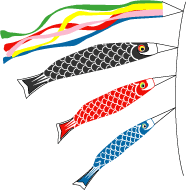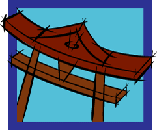 Holidays Holidays
For Japanese, most holidays
are simply days off (they may not even remember which holiday it is!),
and they will take advantage of the free time to go on outings with their
families or significant others. Naturally, traffic on some highways will
be worse on such days, as will the crowds at many tourist destinations.
On the other hand, traffic on other highways may be relatively sparse,
because of the lack of commuters going to work. They are stuck on the
main expressways and train lines going out of the city instead of into
it.
When a national holiday falls
on a Sunday, the following Monday is treated as a holiday.
January 1 — New Year’s
Day
(ganjitsu,
first day of the oshôgatsu season)
New Year’s
in Japan is the most important holiday of the year, similar to Christmas
in the West. In late December, and again in the first few days after January
1, the roads, train stations, and airports are crowded with people going
to and from parents’ houses or tourist destinations. The first five
days of January were once considered to be the New Year’s holidays,
but in recent years many companies have begun returning to work on or
before the fifth.
In the past,
shopping streets were deserted on January 1, but since the late '90s,
larger stores have been staying open. There will be a lot of congestion
around Shinto shrines, where many Japanese go for hatsumodé,
the year’s first (and, for most modern Japanese, only) visit to
a shrine. If you don’t mind major crowds, you may want to visit
a shrine yourself on New Year’s Day and observe Japanese traditions
in action. Also, the Imperial Palace grounds are open to the public on
January 2, with the Emperor appearing several times to wave to the people.
Second Monday of January —
Coming-of-age Day
(Seijin
no Hi; literally, Adults’ Day)
Seijin no Hi honors 20-year-olds—the
age at which Japanese are legally adults, and may drink, smoke, and vote.
Honorees are those who have turned 20 since April 1, or will by the next
April 1. Twenty-year-olds can be seen on this day, the men in suits, the
women in kimono, going to and from local ceremonies in their honor. (Until
2001, this holiday was always January 15.)
February 11 — National
Foundation Day
(Kenkoku
Kinenbi)
This is said
to be the anniversary of the founding of Japan, when Emperor Jimmu ascended
the throne in 660 B.C. Originally called Kigen-setsu (roughly,
“the beginning of recorded history”), it was abolished under
the U.S. postwar occupation, and reinstated with its new name in 1967.
March 20 or 21 — Vernal
Equinox
(Shunbun
no Hi)
Both equinoxes
are important on the Buddhist calendar, being the center of weeklong observance
known as higan. On the equinox day there is usually much traffic
due to people visiting family grave sites, as well as the usual holiday
traffic. If you visit Japanese friends around an equinox, you may be served
ohagi, a ball of rice covered with azuki bean jam. Definitely not finger
food; best eaten with chopsticks.
April 29 — Showa Day
(Shôwa
no Hi)
This is the
birthday of the late Showa Emperor (Hirohito). After he died in 1989, it was named Greenery Day to honor the emperor’s
love of plants. However, in 2007 Greenery Day moved to May 4, and April 29 reverted to being named for the late Emperor.
May 3 — Constitution
Day
(Kempô
Kinenbi)
The second of the “Golden
Week” holidays, commemorating the promulgation of Japan’s
postwar constitution on this date in 1947.
May 4 —Greenery
Day
Since 1985, May 4 had been a holiday simply because it fell between two holidays. But in 2007, it became Greenery Day.
May 5 — Children’s
Day
(Kodomo
no Hi)
Completing
Golden Week is Children’s Day, which actually is celebrated only
by homes with sons. (The March 3 Doll Festival (Hina Matsuri),
celebrated by homes with daughters, is not a national holiday. Draw your
own conclusions from that!) Outside such homes, you will see large wind
socks, printed to look like fish, blowing in the breeze. These represent
carp swimming upstream, a symbol of perseverence that is seen as a model
for Japanese boys.
Third Monday of July —
Ocean Day
(Umi no
Hi)
Originally held on July 20,
this holiday was introduced in 1996. Its main purpose is apparently to
break the long drought of national holidays between Golden Week and Respect
for the Aged Day. Perhaps the ocean was chosen as the focus because people
are likely to go to the beach on this day, especially since the rainy
season ends around then, and school summer vacations begin. It was changed
to the third Monday of July in 2003.
July & August —
The Feast of Lanterns
(Obon)
Obon is not
a national holiday, but it is the focus of the summer vacation season.
It is celebrated at various times in July and August in different parts
of the country, though it is generally thought of as falling in mid-August.
This is when transportation routes out of Tokyo and other large cities
are jammed with people returning to their rural hometowns. Many people
also use this time to travel abroad, which means jammed airports and astronomical
ticket prices. Many companies close during that week, and downtown Tokyo
is virtually deserted.
These months
are filled with numerous local festivals, celebrating either Obon (when
the spirits of dead ancestors are said to pay a visit to their living
relatives) or Tanabata (the date — either July 7 or August 7 —
when the stars Vega and Altair (the Weaver Princess and the Cowherd, according
to Chinese legend) are allowed their only meeting during the year). These
festivals mean local concentrations of traffic, and perhaps the temporary
closure of streets to facilitate the revelry.
Third Monday of September
— Respect for the Aged Day
(Keirô
no Hi)
Intended to encourage respect
for the elderly from younger citizens, this day seems especially important
as we hear more and more about the “graying” of Japanese society.
Previously held on September 15, it was changed to the third Monday in
2003.
September 23 or 24 —
Autumnal Equinox
(Shûbun
no Hi)
Celebrated
in style similar to that of the Vernal Equinox, including crowded roads
leading to cemeteries.
Second Monday of October —
Health and Sports Day
(Taiiku
no Hi)
When the Tokyo
Olympics opened on October 10, 1964, it was an important rung on Japan’s
ladder to becoming a respected member of the international community following
the country’s defeat in World War II. Consequently, that date was
designated as a yearly national holiday, promoting health and exercise.
The observance changed to the second Monday of the month in 2001, making
it the same as Columbus Day in the U.S.
November 3 — Culture
Day
(Bunka
no Hi)
This date was
originally celebrated as the birthday of Emperor Meiji (reigned 1868-1912).
Since 1948, Culture Day has been marked by the presentation by the Emperor
of the Cultural Orders of Merit to outstanding artists and the like. Schools
often hold “Culture Festivals” in early November.
November 23 — Labor
Thanksgiving Day
(Kinrô
Kansha no Hi)
Although now
similar in focus to Labor Day in the U.S., this day was once a harvest
thanksgiving festival known as Niiname-sai (“festival of the new
harvest”). These days, of course, fewer and fewer Japanese earn
their living working in the fields.
December 23 — The Emperor’s
Birthday
(Tennô
no Tanjôbi)
This is one
of only two days during the year when a special section of the Imperial
Palace garden is open to the public; the other is around New Year’s,
usually January 2. There are many local festivals throughout the year.
You can call the Japan National Tourist Organization (JNTO), which Ian
L. McQueen, in A Budget Travel Guide to Japan
(Kodansha, 1992), calls “the best single source for information
on Japan.” Their Tourist Information Centers are located at Tokyo’s
Narita Airport; in the Tokyo International Forum, near JR Yurakucho Station;
and near Kyoto Station. They may be reached by phone at:
Tokyo 03-3201-3331
Teletourist
(recorded info on Tokyo events) 03-3201-2911
Kyoto 075-371-5649
Nationwide
tourist information
(toll-free)
0120-444-800
View from
Japan home
|


 This page last updated
May 7, 2009
. E-mail Tim
This page last updated
May 7, 2009
. E-mail Tim